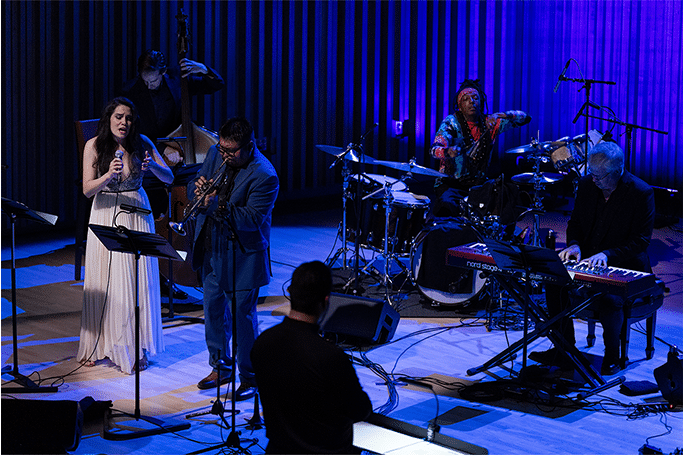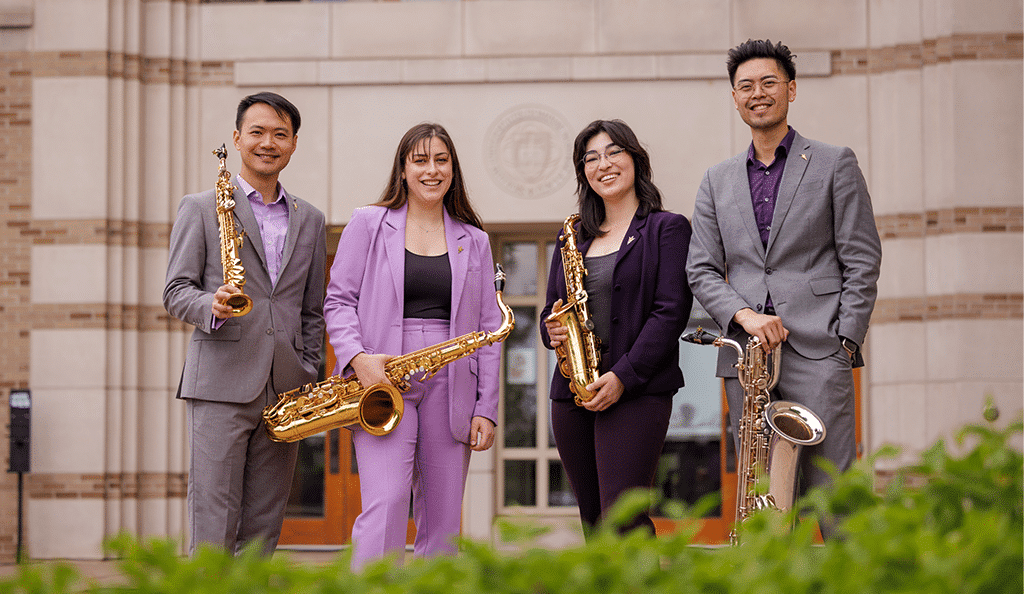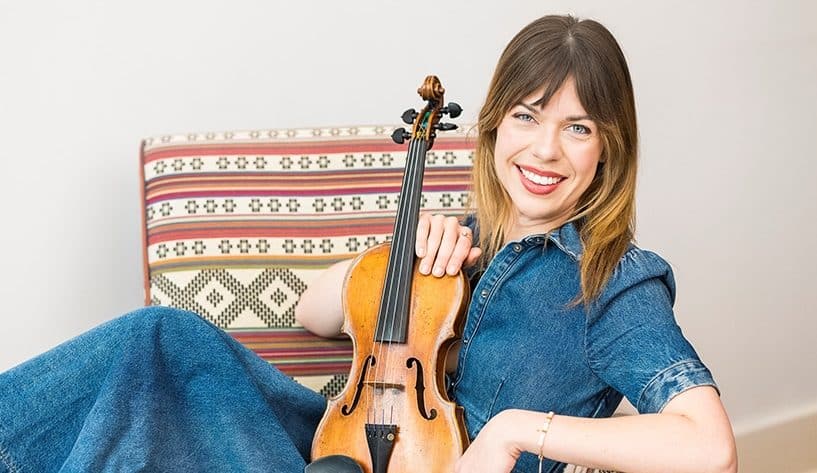Meet the Grantees: Julia Keefe
Indigenous jazz vocalist and bandleader embraces the intersectionality of jazz and Native American music.

Jazz vocalist, actor, advocate, and educator Julia Keefe is pioneering a new way for Indigenous artists to be celebrated in modern-day jazz. Though she has encountered her share of challenges—especially those with narrow musical minds—Keefe has never shied away from elevating artists who proudly share their Indigeneity. With these goals in mind, the recent CMA grantee has proven to be an unstoppable force: co-founding the Julia Keefe Indigenous Big Band alongside fellow Native American jazz trumpeter Delbert Anderson and spearheading the Mildred Bailey Project, which highlights the history and future of Indigenous artists in jazz.
Ahead of the submission deadline on October 10 for the 2025 Presenter Consortium for Jazz (PCJ) grant applications, we chatted with Keefe about her experience as a PCJ grantee, performing with the consortium of presenters who received financial support for the 2024 Blue Desert Tour, as well as the her current projects uplifting and spotlighting the work of fellow Indigenous jazz musicians.
You have a long list of high-profile collaborators. Any favorite stories?
I have been so blessed to collaborate with so many phenomenal musicians. I think my absolute favorite was my most recent collaboration with Esperanza Spalding at the Kennedy Center. She was invited to join the Julia Keefe Indigenous Big Band for our weeklong residency and joined us onstage for the Mary Lou Williams Jazz Festival. She is such a musical and spiritual master, and I learned so much from making music and speaking with her. She sang one of my compositions, which was truly an honor, but her presence alone in that space was such a gift, both musically and energetically. I’d love to collaborate again.
Tell us about the intersectionality of your pride for your Indigenous roots and your musical practice or identity?
My Indigeneity is absolutely an aspect of my identity that I am incredibly proud of, but it took me some time to truly integrate it into my musical identity. While I was coming up as an artist, I would introduce myself as a “Native American jazz singer,” and folks had a really hard time with that—ideas of “Native American music” came into conflict with their ideas of “jazz music.” I really only felt safe to marry those two parts of my identity when I was talking about Native American jazz singer Mildred Bailey (Coeur d’Alene). It wasn’t until my late 20s and early 30s when I felt empowered enough to shrug off misconceptions and projections about who or what I am and just be me unapologetically. Nowadays, people might not “get” me as a mixed Indigenous jazz musician, but that sounds like a them problem.

How did the idea of an Indigenous Big Band come to fruition?
The idea for the Indigenous Big Band came about when I met my wonderful friend and collaborator Delbert Anderson (Diné) for the first time. We connected to discuss the first Blue Desert Tour in 2021, which was virtual due to Covid lockdowns. He found me on Facebook, and what was supposed to be a short get-to-know-you call turned into a three-hour brainstorming session. We started talking about how cool it would be to have an all-Indigenous big band, and I told Delbert about how Native big bands and jazz ensembles aren’t without precedent. For those who survived the Indian boarding school experience, they came back to their traditional homelands with this knowledge of western music, instruments, and formed their own big bands, marching bands, and smaller ensembles. Indigenous jazz was alive and well on reservations and tribal lands all across the US and Canada during the height of jazz’s popularity. With all this in mind and the Indigenous big band dream in our back pocket, Delbert and I waited for the right opportunity.
When South Arts Jazz Roads announced their Creative Artist Residency grant, Delbert called me up and told me to apply for the Indigenous big band, which ended up being awarded with full funding. Then came the panic of finding Indigenous jazz musicians to fill the ranks. I thought to myself, “Oh man, did I just make a promise to this giant funder that I can’t fulfill? Are there even enough Indigenous jazz musicians out there?!” After having a little panic attack, I went about conducting outreach to colleges and Native student unions. I made a post on social media calling for artists and the response was overwhelming! We now have a huge roster of Indigenous jazz musicians, enough for several big bands. My hope is to one day have a conference or festival where we can all get together and jam, conduct workshops and lectures, and build community.
The Blue Desert Tours have been funded since 2021 through CMA’s Presenter Consortium for Jazz program, and earlier this year you hit the road with Delbert Anderson and IndigieFemme to perform at the Northwest New Mexico Arts Council, gallupARTS, and the Southwest Colorado Canyon Alliance. Do you have a favorite memory from the 2024 Blue Desert Tour you can share with us?
Yes! The Blue Dessert Tour has been happening since 2021 thanks to the amazing Delbert Anderson and the CMA Presenter Consortium Grant, and I have been part of the tour as a band leader from the first year. On the 2024 Blue Desert Tour, we had the best time sharing our songs and stories with the communities in New Mexico and Colorado, though my favorite memory was performing at the outdoor venue in Farmington, New Mexico. It was so beautiful and so many people showed up to support the bands. The energy was light, and everyone had a blast. Seeing little kids dancing around while you perform is a true blessing. It’s why I do this.
You are also 2022 Performance Plus grantee, leading the Mildred Bailey Project. Can you share more?
The Mildred Bailey Project has been something I have been working on since 2009, and thanks to CMA I finally was able to get into the studio to record it! The arrangements are reductions of big band arrangements that Mildred Bailey once sang, so with the nonet ensemble of the Mildred Bailey Project, we capture that big band sound with half the real estate. It was a phenomenal time working with the amazing musicians and every person involved brought their professionalism and thoughtfulness to the material; guiding the music in such delicate ways that it really is the best this music has sounded. I can’t wait to share the rest of the album with the world!
Do you have any advice for ensembles applying for our program or any of our CMA grant programs?
Demonstrate your capacity to get the work done. Highlight your history of managing complex projects and budgets, any community partners you might have, and if anyone else is investing in your project. I believe the selection committee wants to feel confident that you can make this project across the finish line. Finally, I think the best advice I can give is be specific. It’s so easy to list the million amazing ideas you have, so choose your strongest idea that fits within the grant guidelines and believe in this work. Let your grant writing communicate just how much you believe in this work. If you pitch your project as something that will happen with or without the grant funding, then it puts you in a place of power – the funder has the opportunity to attach itself to your amazing idea, so they better jump on this train before it leaves the station.
And we ask each grantee that we interview this: if the Julia Keefe Trio was a sandwich, which would it be and why?
Probably a Potbelly’s Veggie Melt on whole wheat with artichokes, hot peppers, olives, avocado, and Italian seasoning. Why? Because it’s delicious.
To stay up to date with all of Julia’s projects, head over to her website juliakeefe.com or following her on social media @JuliaKeefeOfficial. The first single from The Mildred Bailey Project and her EP are now streaming wherever you get your music.



